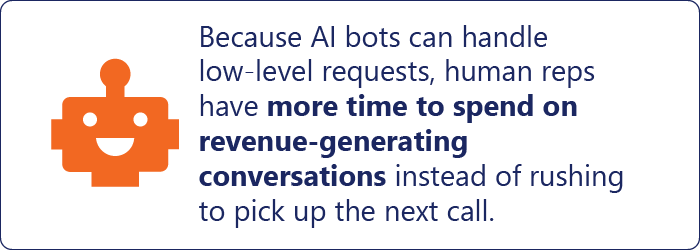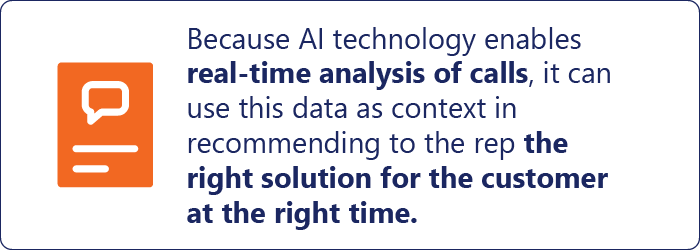4-minute read
Quick summary: Call center AI tools enable customer service organizations to empower their reps and evolve from cost centers to revenue generators.
Contents
Will AI replace call center agents?
10 AI call center use cases for empowering customer service reps to generate revenue
2. Suggesting the next best action
3. Delivering automatic summaries
4. Recommending knowledge base content
5. Delegating to virtual assistants
6. Offering payment arrangement widgets
7. Empowering agents with response suggestions
9. Gaining access to predictive analytics
AI delivers real results in customer service KPIs
Taking the customer care rep experience to a new level
The future of AI in call center applications
Many customer service organizations are already familiar with the cost-saving benefits of call center AI technologies. Gartner predicts that, by 2026, conversational AI within contact centers will reduce costs by $80 billion. However, today’s enterprises are looking beyond cost cutting and recognizing how empowering agents with AI can transform customer service organizations from cost centers into revenue-generating assets.
Meet your new sales force
Through call center AI applications, customer service reps tap into valuable insights that empower them to turn customer interactions into selling opportunities. And because AI bots can handle low-level requests such as password resets, human reps have more time to spend on revenue-generating conversations instead of rushing to pick up the next call.
When a major telecom enterprise put this principle into practice, they found it quite easy to train their customer service reps in the art of selling products and services. Call center reps deal with customers directly day in and day out, so it’s only natural that they become experts in the problems and aspirations surrounding the customer experience. This expertise forms a solid foundation for reps to capitalize on opportunities for discussing the organization’s latest promotions, new products, upgrade offers, and more.
Will call center AI replace agents?
The short answer is no. The fact is that call center AI technology is still limited in its capabilities. It’s unlikely that call center AI software will replace human agents anytime soon.
One big reason is that AI isn’t empathetic yet, meaning it can’t deal with human emotions like a customer service rep can. Thus, a virtual agent cannot replicate the most critical functions of a human agent, such as building rapport, detecting customer sentiment, and creating an authentic connection with the caller.
Another reason is that AI can’t think on its feet. It can only solve problems and deal with the situations it’s trained to. Human agents, on the other hand, can adapt to any situation and come up with creative solutions.
Additionally, AI, like any technology, can make mistakes. AI systems, particularly those based on machine learning, rely heavily on its training data. The AI’s responses might be inaccurate or inappropriate if the training data is limited or biased.
The bottom line is that customer interactions are complex, nuanced, and unpredictable. AI still lacks the genuine care and human touch essential to fostering trust in a call center environment.
It’s important to note that AI and human agents often work best in tandem. AI can handle routine, repetitive tasks efficiently, freeing human agents to deal with more nuanced or creative problem-solving tasks. This combination can lead to a more efficient and effective problem-solving process overall.

6 call center AI use cases for empowering customer service reps to generate revenue
Customer service organizations are leveraging artificial intelligence for call centers in various ways to accelerate the resolution of customer issues and to deliver context-based insights to human agents. Both these outcomes help call centers transform into revenue generators by
• Allowing the reps more time for discussing products and services
• Providing customer-specific information that reveals selling opportunities
1. Uncovering customer intent
In traditional customer service interactions, it often takes the rep several minutes of question-and-answer to discover the caller’s true intent. AI and machine learning–based intent prediction models can analyze call content in real time and compare it with known “trigger topics.” They can then pinpoint the reason for the customer’s call with high accuracy and deliver the exact resources the agent needs to resolve the issue promptly.
2. Suggesting the next best action
Because call center AI technologies enable real-time analysis of calls, they can use this data as context in recommending to the rep the right solution for the customer at the right time.
3. Delivering automatic summaries
Customer service agents have historically spent considerable time taking notes during customer calls, which not only diverts their attention from the conversation but also involves a high risk of error. Call center AI enables the creation of summaries automatically at the end of each call, which can then be stored in the customer record as context for the next interaction.

4. Recommending knowledge base content
Customer service representatives can spend as much as 5 to 10 minutes per call searching through the organization’s knowledge base for information they need regarding promotions, troubleshooting steps, internal system notifications, etc. AI models can be trained to predict and deliver the most relevant knowledge base articles for resolving the specific issue based on the customer’s profile and/or activity.
5. Delegating to virtual assistants
By implementing AI-powered virtual assistants (“chatbots”), organizations offer customers the opportunity to self-serve for simple tasks like resetting a password or changing an address. More requests handled by call center AI means fewer calls and messages going to human agents, who are then freed up to spend more time on revenue-driving activities.
6. Offering payment arrangement widgets
For some organizations, many of their customer service interactions center around bill payments, and many of these can be resolved by offering the customer a payment arrangement. By building payment arrangement widgets into their virtual assistant platforms, organizations can leverage AI to
1. Auto-detect the customer intent from inputs such as “I can’t pay my bill this month.”
2. Determine which payment arrangement(s) are available to the customer based on their profile.
3. Deliver a link to a self-service form where the customer can review terms and choose a payment plan.

7. Empowering agents with response suggestions
The best use case of call center AI is utilizing it to supplement an agent’s capabilities instead of replacing them. Response suggestion is a fantastic example.
Here, AI generates a set of recommended responses that a human agent can use. These are based on real-time conversation analysis, historical data, and predefined patterns.
The benefit is that agents can deliver more accurate, timely, and effective responses, improving the agent’s performance. In addition, it improves the chance of novice agents saying the right things even without too much training.
AI can even suggest personalizations based on the caller’s profile, purchase history, and demographics. For instance, AI can bring up a product the customer bought before so that the human agent can suggest something similar.
8. Improving call routing
Call center AI can be used before an agent has even lifted the phone through a process called routing.
Traditionally, calls in contact centers are routed to agents based on set criteria. For instance, a long-term customer or VIP can be directed towards the senior agents on the customer service team.
AI optimizes this process significantly by making routing decisions faster and on the fly. These can be based on customer data gathered from multiple channels such as chat, email, and the company database.
For instance, AI can identify that a customer has a specific need based on their history or language. The system can then route the call to an agent who’s skilled at tackling that particular customer issue.
AI can even route calls to another channel. If a customer says he prefers chat, then AI can automatically connect them to a chatbot or agent.
9. Gaining access to predictive analytics
Predictive analytics is a powerful tool that lets call center AI make operational suggestions for the call center based on history.
The common application to this is call volume forecasting. In this case, AI predicts the volume of calls based on historical data and seasonal patterns. Therefore, it can recommend adding or removing agents accordingly, enabling the center to meet demand while reducing costs.
AI tools can also make churn predictions, identifying “at-risk” callers more prone to complaining or dropping out. Call centers can use this information to adopt a better approach or implement targeted retention strategies.
Predictive analytics also helps segment customers based on criteria such as purchasing behavior, demographics, or interaction history. This lets agents tailor-fit their approach for a better customer experience.
10. Helping detect fraud
AI can pick up on the subtle hints that could indicate that a caller is involved in fraud. Plus, it has instant access to a wide range of data to detect anomalies much faster.
For instance, voice biometrics can analyze the caller’s voice and match that with a saved voice clip from a legitimate user. If AI detects inconsistencies, it will flag it as fraud.
Call center AI can also analyze the speech patterns of the caller and uncover any deviations in language, tone, or behavior. Sudden changes, such as nervousness, may trigger the caller as a potential fraud. AI can even compare voices from a database of known fraudsters.
The good news is that, over time, machine learning algorithms can train AI to spot inconsistencies much better. It can also analyze new data to adapt to new fraud techniques.
Call center AI delivers real results in customer service KPIs
Because happy customers are more likely to generate repeat business and referrals, improving customer satisfaction can have a dramatic positive impact on revenues. When we worked with our telecom client to implement AI for their call center reps, the impact on customer service KPIs was significant:
• Automatic summaries shortened call resolution times by an average of 26 seconds, resulting in an estimated $20 million+ saved per year in call center operating expenses.
• Customer intent prediction was scaled to more than 20,000 agents servicing 20+ million messaging interactions per year, shortening the average conversation by a minute or more.
• AI-driven knowledge base search improved first call resolution (FCR) rates and led to an overall increase in Net Promoter Scores (NPS) and Customer Satisfaction Scores (CSAT) with customers on the phone.
• Applying AI to the payment arrangement experience reduced customer callbacks by over 7 percent.
Taking the customer care rep experience to a new level
When customers call a contact center, they trust the agent to resolve their issue in a way that produces the best possible outcome. By implementing call center AI solutions for their representatives, customer service organizations build on their human team’s ability to solve problems when they make customers aware of the products and services that can enhance their experience.
The result is a win-win-win: the customer learns about solutions tailored to their needs and preferences, the agent gets to help the customer in ways not available to them previously, and the company builds revenues by opening up new sales opportunities.
The future of call center AI
As you can see, AI is revolutionizing the call center industry.
But while call center AI solutions likely won’t replace human agents, they do empower reps to improve their performance and efficiency dramatically. In areas ranging from automatic call routing to omnichannel integration, virtual agents can deliver cost efficiencies while improving the customer experience.
As AI becomes smarter, faster, and more responsive, brand-new applications will continue to arise, and soon it will become the standard tool for call centers. That’s why the best time to embrace AI for customer service is now, allowing you to stay ahead of the curve.

Digital transformation done right
We create powerful custom tools, optimize packaged software, and provide trusted guidance to enable your teams and deliver business value that lasts.

Paul Lee is a Senior Manager in Logic20/20’s Digital Transformation Consulting practice, with experience in digital, customer experience strategy, and technology implementation engagements.

